Merry Christmas everybody! I know you will be very busy in your kitchens today (or at the malls, getting your last minute Christmas shopping done!), but I just could not stop myself from sharing this special recipe with all of you today: Panettone!
I had already seen it last year and I have been waiting impatiently for this Christmas to come, so I could try and make my own panettone. You see, panettone is THE Christmas dessert par excellence in every single Italian home. There is no Christmas without panettone.
We do have many variations of it (with chocolate chips, chocolate ganache, crema pasticcera… you name it), but in my opinion, the classic panettone with candied citrus and raisins is unbeatable.
There are many folk stories and legends about this dessert and its origins, but the only thing everyone agrees on is that it was created in Milano, my home town. The word panettone literally means “big sweet bread” and it is very ancient… it appears to have been invented during the Roman Empire and, after undergoing a series of adjustments, it is still our favourite Christmas dessert.
This was my first attempt at making it at home and I have to say that I am quite satisfied with the result! This recipe calls for fresh brewer’s yeast and, though traditionally panettone is made with sourdough and a starter, I think this little shortcut works great.
The hardest thing was to find a flour strong enough to make it! Apparently, there are no flours with a high protein content in Sydney (see notes for more information on the flour I used)!
It takes a long time, but it is not hard to make and it tastes so much better than store-bought ones, especially the industrial ones that you get here. Try it and let me know how you like it in the comment section below!
In the meantime, I would like to wish you and all your loved ones a very Merry Christmas and a special grazie to Giulia from AlterKitchen for inspiring me to try out this amazing recipe and for all her advice!
Recipe adapted from AlterKitchen and Menta e Cioccolato
Ingredients (makes 1 panettone of 1 kg – 2.2 lbs., mold of 18 cm – 7 inches in diameter and 12 cm – 4.75 inches in height):
First dough, 6 AM
13 gms – 0.5 oz. water
2 gms – 0.07 oz. fresh brewer’s yeast
A pinch sugar
20 gms – 0.7 oz. high protein flour
Second dough, 7 AM
Previous dough
7 gms – 0.25 oz. egg yolk
18 gms – 0.6 oz. water
37 gms – 1.3 oz. high protein flour
3 gms – 0.1 oz. sugar
Third dough, 8:30 AM
Previous dough
33 gms – 1.15 oz. water
7 gms – 0.25 oz. egg yolk
67 gms – 2.35 oz. high protein flour
2 gms – 0.07 oz. fresh brewer’s yeast
3 gms – 0.1 oz. sugar
Fourth dough, 12 noon
Previous dough
333 gms – 11.75 oz. high protein flour
33 gms – 1.15 oz. egg yolks
180 gms – 6.35 oz. whole eggs
113 gms – 4 oz. sugar
100 gms – 3.5 oz. unsalted butter, softened
2 gms – 0.07 oz. Panettone essence (or lemon + orange essences)
1/3 vanilla bean
5 gms – 0.18 oz. salt
167 gms – 5.9 oz. raisins, soaked in warm water and dried very well
67 gms – 2.35 oz. candied orange peel, finely chopped
33 gms – 1.15 oz. candied citron peel, finely chopped
Instructions:
First dough, 6 AM
Warm up the water, add the sugar and dissolve the yeast in it. Make sure the water is not too hot or the yeast will not work.
Add this mixture to the flour and knead well with your hands.
Make the dough into a ball, put it in a bowl covered with cling wrap and keep it in a warm place to rise until doubled ( this will take approximately 1 hour).
Second dough, 7 AM
Knead all the ingredients together with your hands.
Make the dough into a ball, put it in a bowl covered with cling wrap and keep it in a warm place to rise until doubled (this will take approximately 1 hour).
Third dough, 8:30 AM
Put all the ingredients in the bowl of an electric mixer fitted with the paddle attachment and knead well. Make the dough into a ball and re-put it in the bowl. Cover it with cling wrap and keep it in a warm place to rise for 2 hours.
Fourth dough, 12 noon
Add the whole eggs, the egg yolks, half the sugar and flour (but reserve 3 tablespoons) to the bowl with the previous dough (the one of 8:30AM). Knead well with the paddle attachment for a few minutes until your dough looks smooth.
Now add the remaining sugar and essences and keep kneading to string up the dough.
Dry the soaked raisins well with a paper towel and scrape the seeds of the vanilla bean (I followed Giulia’s suggestion and I rubbed them on the butter… so I did not waste any!).
Divide the butter in 3 pieces and add it (one piece at a time) to the dough, alternating it with a tablespoon of flour at a time. Add the second and third piece/tbsp. only after the previous ones have been well incorporated in the dough.
Add the salt and continue kneading with the paddle attachment until your dough becomes very smooth and elastic. You will know it is ready when it starches around the paddle attachment, like a mozzarella string stretching out of a pizza!
Now add the chopped candied fruit and dried raisins and knead everything together.
Make a ball with the dough and put it to rest, covered, on a lightly floured surface for 30 to 40 minutes.
Now you are ready to put the dough into the cardboard mold. To do this, first place the mold onto a baking sheet (so you don’t need to move it after the panettone has risen – you don’t want to risk that it deflates!), and then you will need to do what is known as pirlatura, which basically means shaping the dough into a ball. You do this by putting your hands with your palms facing each other as if you’re about to clap on the sides of the ball. Then move your hands forward and backward to try and round up the dough. Make sure your hands are well greased with melted butter as the dough is a bit sticky! It is much easier than it sounds. Click here to see a video on how to do the pirlatura.
Put the rounded dough into the mold, cover it with cling wrap and put the dough to rise until it reaches the edge (or it is just below – it will keep rising while baking). This will take at least 5 hours, depending on the temperature, yeast and other factors. I kept mine to rise for about 8 hours (I put it in the mold at around 1 PM and baked it at about 9 PM), but I could have kept it a bit longer too!
9 PM
Take the cling wrap off so that the top dries out a bit and pre heat the to 175°C – 347°F.
Take a sharp knife and grease it with butter to make the cut at the top. You have 2 options: make a cross shaped cut and put some butter in the cuts; or make the cross shaped cut, then, using a very sharp knife, “peel” the “ears” backwards, brush the inside with melted butter and reposition the ears on the top. Here are two videos on how it’s done – click here and here.
Bake the panettone for 50 minutes, covering the top with aluminium foil if it is getting too brown. Make sure to check if the panettone is fully cooked by inserting a thin wooden skewer in the middle (if it comes out dry and clean, it is ready). But do not over bake it or it will dry out (I kept mine for a few minutes more and I wished I hadn’t – remember it will keep cooking even after you take it out of the oven)!
When ready, you’ll need to let it cool upside down (so that it does not deflate). I inserted 2 long skewers from side to side (or you can use knitting needles) at approximately 2 cm – 1 inch from the bottom and I hung it between 2 chairs. Let it cool down like this overnight.
To store it, wrap it in a plastic bag (I used the bag of a store bought panettone that I had kept) until you eat it, so it will remain soft. It is best eaten after 3 or 4 days.
NOTES
1. Flour – The original recipe calls for a very strong flour (that we call Manitoba in Italy as it is made from Canadian wheat). I was unable to find it in Sydney! I did some research and apparently, the higher the protein level, the stronger the flour. I looked everywhere for a flour with a protein level of 14% or 15% (like the Manitoba flour), but found nothing. The only thing I found was an Italian bread flour (yes… straight from Italy!), that had a content of 12.6%… and I had to settle for that! The other varieties of bread flour I saw here only had an 11.5% proteins! A bit disappointing…
2. I let the dough rise in my oven. I keep the oven off, but turn the light on… this is enough to warm it up just enough to help the dough rising.
3. Use a VERY sharp knife to make the cross shaped cut on the top, it will make it much easier and cleaner.
4. Making panettone is not hard, but it takes time (the whole day!) and you need to be precise in measuring the ingredients… you do need a digital scale!
5. I got the paper molds from Italy… but I am quite sure you should be able to get them online too. Or you could substitute them with a high round tin.
6. For all Sydneysiders… I got my fresh brewer’s yeast in Haberfield at Zanetti’s.
Don’t forget to pin this post!
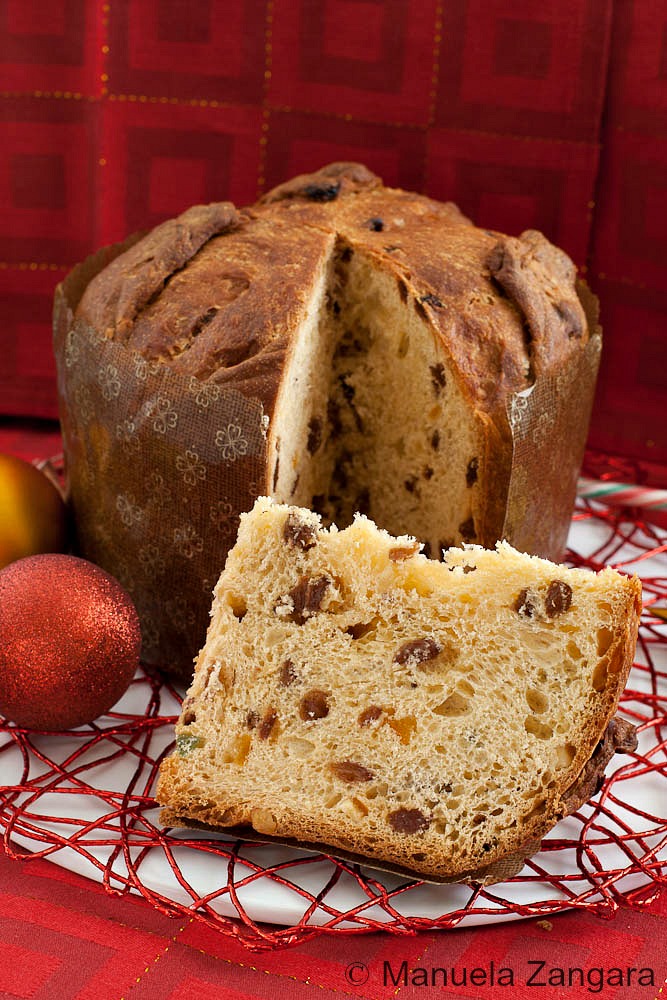
Panettone
Panettone - a traditional Italian Christmas cake.
Ingredients
First dough, 6 AM
- 13 gms – 0.5 oz. water
- 2 gms – 0.07 oz. fresh brewer's yeast
- A pinch sugar
- 20 gms – 0.7 oz. high protein flour
Second dough, 7 AM
- Previous dough
- 7 gms – 0.25 oz. egg yolk
- 18 gms – 0.6 oz. water
- 37 gms – 1.3 oz. high protein flour
- 3 gms – 0.1 oz. sugar
Third dough, 8:30 AM
- Previous dough
- 33 gms – 1.15 oz. water
- 7 gms – 0.25 oz. egg yolk
- 67 gms – 2.35 oz. high protein flour
- 2 gms – 0.07 oz. fresh brewer's yeast
- 3 gms – 0.1 oz. sugar
Fourth dough, 12 noon
- Previous dough
- 333 gms – 11.75 oz. high protein flour
- 33 gms – 1.15 oz. egg yolks
- 180 gms – 6.35 oz. whole eggs
- 113 gms – 4 oz. sugar
- 100 gms – 3.5 oz. unsalted butter softened
- 2 gms – 0.07 oz. Panettone essence or lemon + orange essences
- 1/3 vanilla bean
- 5 gms – 0.18 oz. salt
- 167 gms – 5.9 oz. raisins soaked in warm water and dried very well
- 67 gms – 2.35 oz. candied orange peel finely chopped
- 33 gms – 1.15 oz. candied citron peel finely chopped
Instructions
First dough, 6 AM
-
Warm up the water, add the sugar and dissolve the yeast in it. Make sure the water is not too hot or the yeast will not work. Add this mixture to the flour and knead well with your hands. Make the dough into a ball, put it in a bowl covered with cling wrap and keep it in a warm place to rise until doubled ( this will take approximately 1 hour).
Second dough, 7 AM
-
Knead all the ingredients together with your hands. Make the dough into a ball, put it in a bowl covered with cling wrap and keep it in a warm place to rise until doubled (this will take approximately 1 hour).
Third dough, 8:30 AM
-
Put all the ingredients in the bowl of an electric mixer fitted with the paddle attachment and knead well. Make the dough into a ball and re-put it in the bowl. Cover it with cling wrap and keep it in a warm place to rise for 2 hours.
Fourth dough, 12 noon
-
Add the whole eggs, the egg yolks, half the sugar and flour (but reserve 3 tablespoons) to the bowl with the previous dough (the one of 8:30AM). Knead well with the paddle attachment for a few minutes until your dough looks smooth.
-
Now add the remaining sugar and essences and keep kneading to string up the dough.
-
Dry the soaked raisins well with a paper towel and scrape the seeds of the vanilla bean (I followed Giulia’s suggestion and I rubbed them on the butter… so I did not waste any!).
-
Divide the butter in 3 pieces and add it (one piece at a time) to the dough, alternating it with a tablespoon of flour at a time. Add the second and third piece/tbsp. only after the previous ones have been well incorporated in the dough.
-
Add the salt and continue kneading with the paddle attachment until your dough becomes very smooth and elastic. You will know it is ready when it starches around the paddle attachment, like a mozzarella string stretching out of a pizza!
-
Now add the chopped candied fruit and dried raisins and knead everything together.
-
Make a ball with the dough and put it to rest, covered, on a lightly floured surface for 30 to 40 minutes.
-
Now you are ready to put the dough into the cardboard mold. To do this, first place the mold onto a baking sheet (so you don’t need to move it after the panettone has risen – you don’t want to risk that it deflates!), and then you will need to do what is known as pirlatura, which basically means shaping the dough into a ball. You do this by putting your hands with your palms facing each other as if you're about to clap on the sides of the ball. Then move your hands forward and backward to try and round up the dough. Make sure your hands are well greased with melted butter as the dough is a bit sticky! It is much easier than it sounds. Click here http://www.youtube.com/watch?v=QGjLNfQREdg to see a video on how to do the pirlatura.
-
Put the rounded dough into the mold, cover it with cling wrap and put the dough to rise until it reaches the edge (or it is just below – it will keep rising while baking). This will take at least 5 hours, depending on the temperature, yeast and other factors. I kept mine to rise for about 8 hours (I put it in the mold at around 1 PM and baked it at about 9 PM), but I could have kept it a bit longer too!
9 PM
-
Take the cling wrap off so that the top dries out a bit and pre heat the to 175°C – 347°F.
-
Take a sharp knife and grease it with butter to make the cut at the top. You have 2 options: make a cross shaped cut and put some butter in the cuts; or make the cross shaped cut, then, using a very sharp knife, “peel” the “ears” backwards, brush the inside with melted butter and reposition the ears on the top. Here are two videos on how it’s done – click here http://www.youtube.com/watch?v=LmCnv4J-zpg and here http://www.youtube.com/watch?v=kJP4mT48Xog.
-
Bake the panettone for 50 minutes, covering the top with aluminum foil if it is getting too brown. Make sure to check if the panettone is fully cooked by inserting a thin wooden skewer in the middle (if it comes out dry and clean, it is ready). But do not over bake it or it will dry out (I kept mine for a few minutes more and I wished I hadn’t – remember it will keep cooking even after you take it out of the oven)!
-
When ready, you’ll need to let it cool upside down (so that it does not deflate). I inserted 2 long skewers from side to side (or you can use knitting needles) at approximately 2 cm – 1 inch from the bottom and I hung it between 2 chairs. Let it cool down like this overnight.
-
To store it, wrap it in a plastic bag (I used the bag of a store bought panettone that I had kept) until you eat it, so it will remain soft. It is best eaten after 3 or 4 days.
Recipe Notes
1. Flour – The original recipe calls for a very strong flour (that we call Manitoba in Italy as it is made from Canadian wheat). I was unable to find it in Sydney! I did some research and apparently, the higher the protein level, the stronger the flour. I looked everywhere for a flour with a protein level of 14% or 15% (like the Manitoba flour), but found nothing. The only thing I found was an Italian bread flour (yes… straight from Italy!), that had a content of 12.6%… and I had to settle for that! The other varieties of bread flour I saw here only had an 11.5% proteins! A bit disappointing… 2. I let the dough rise in my oven. I keep the oven off, but turn the light on… this is enough to warm it up just enough to help the dough rising. 3. Use a VERY sharp knife to make the cross shaped cut on the top, it will make it much easier and cleaner. 4. Making panettone is not hard, but it takes time (the whole day!) and you need to be precise in measuring the ingredients… you do need a digital scale! 5. I got the paper molds from Italy… but I am quite sure you should be able to get them online too. Or you could substitute them with a high round tin. 6. For all Sydneysiders… I got my fresh brewer’s yeast in Haberfield at Zanetti’s.
You can also try making your own Pandoro!

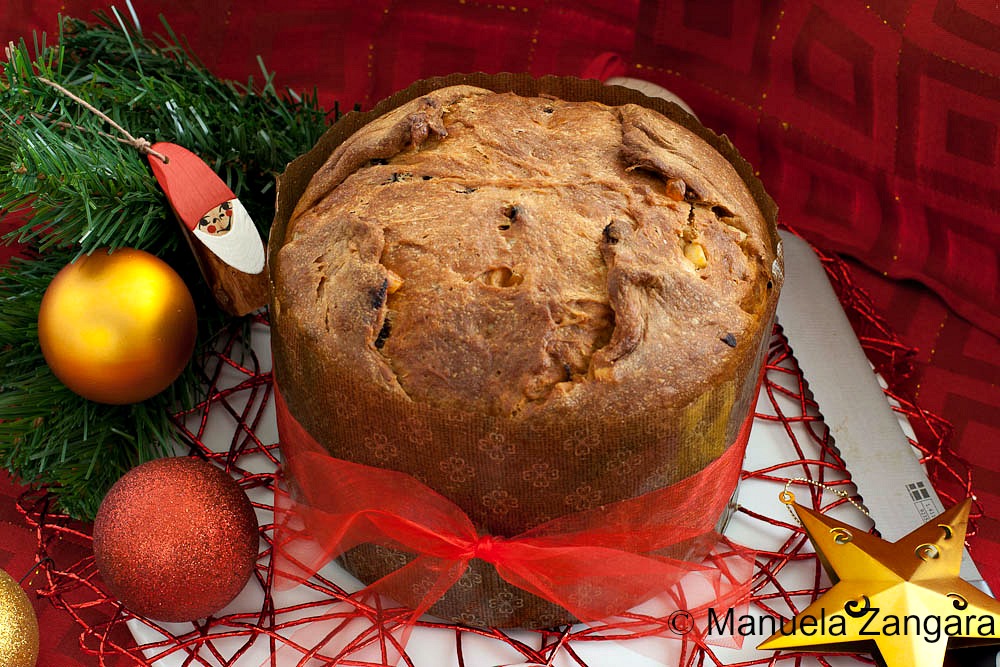









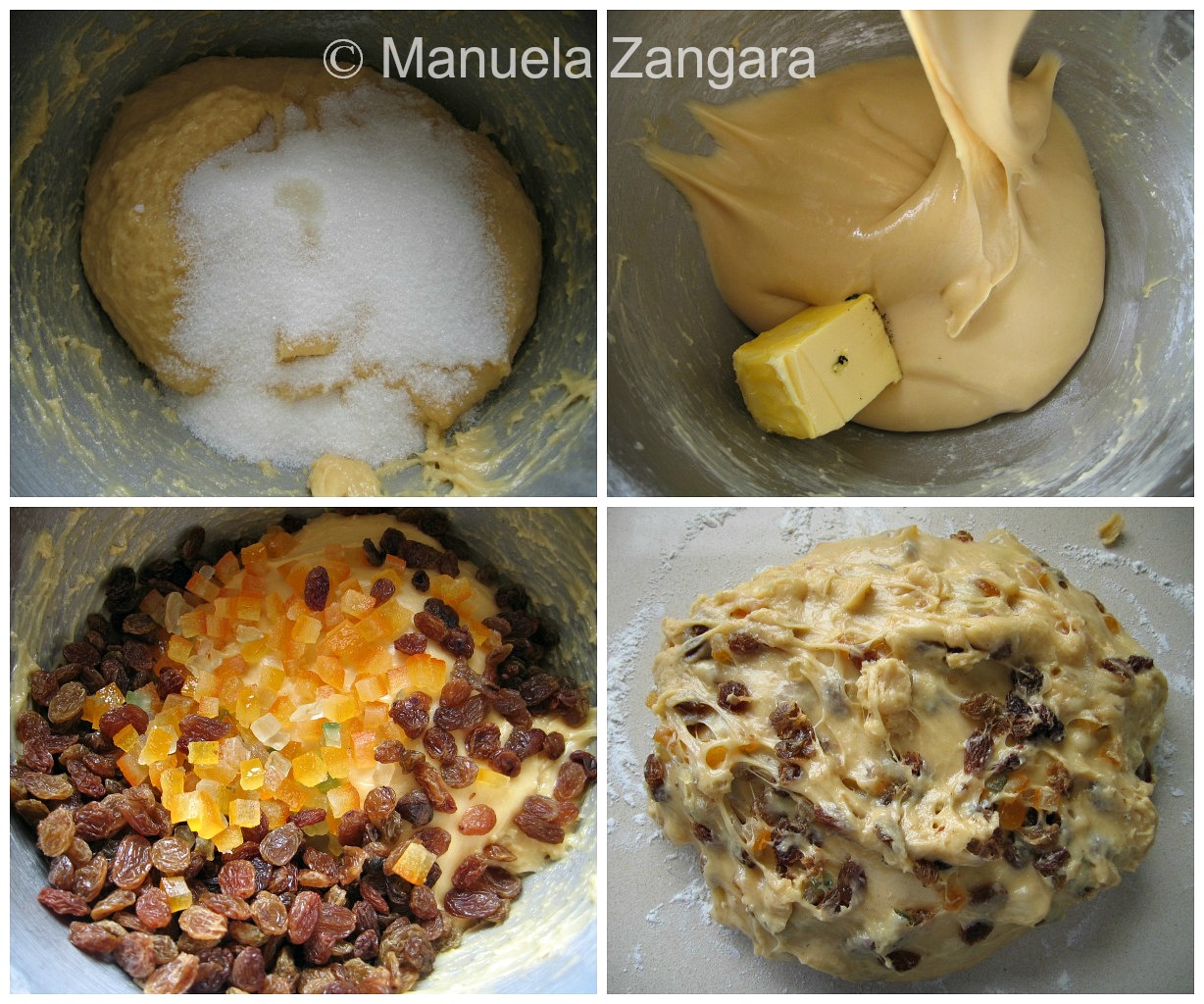






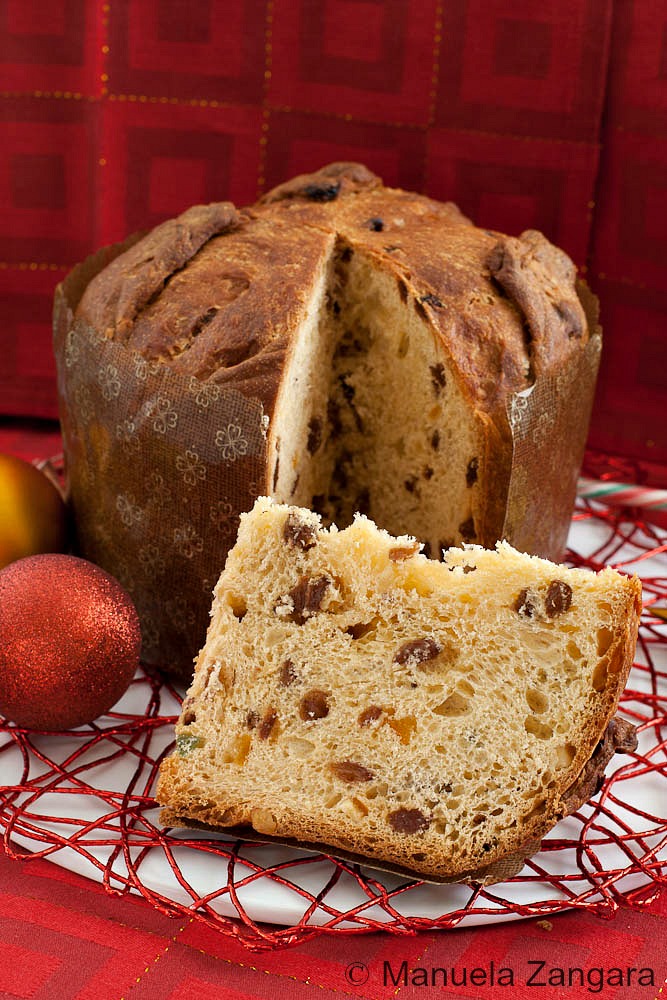




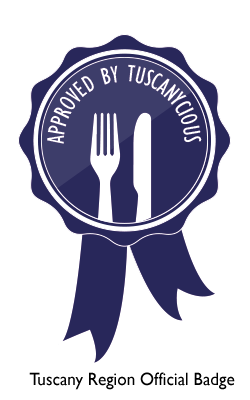












Can I put the first dough in fridge overnight after rising .
Can I put the the final dough in fridge overnight then put in mold to final rise .and can I add honey to dough and how much if it possible
Very pleased with the outcome, the recipe is shorter than standard Italian ones but it tasted great and was very moist. Really enjoyed making this panettone. Easy to follow, looked and smelled amazing when it came out of the oven. Definitely will try once more.
Excellent recipe! I replaced the eggs and dairy with vegan eggs (The Vegg Baking Egg Replacement) and vegan butter (Coconut based) – both from the Cruelty Free Shop in Sydney. And I found 13.5% protein flour at Zanetti’s in Haberfield. Italian Cedro and Candied Orange peel from The Essential Ingredient in Rozelle. Fior d’Arancia and Limone essences from Lamonica IGA in Haberfield.
I don’t have a Kitchenaid so did all the kneading by hand, and couldn’t find Panettone papers so made some out of heat-safe paper bags and staples. I also used instant yeast (1/3 of the fresh yeast quantity). Next time I’ll use the fresh yeast for a bit more rising power, but still worked really well. Final rise was 12 hours.
The result: Excellent, totally delicious, best Panettone I’ve ever had!! Thank you Manu!
Yay!!! I am so happy you liked it!! And thanks for all the tips on where the find the needed ingredients here in Sydney! That’s really helpful for me as well!
I hope you had a fantastic Christmas!
Manu
I have had my panettone in the oven for over an hour and a half now and it is still not cooked! There is only 4g of yeast in the whole thing, which doesn’t seem near enough as the parts that are cooked seem very dense and heavy. My oven is fine as I’ve been baking all week without any problems. What could I have done wrong?
Hi Trish. Did you use fresh brewer’s yeast? If you have used other kinds of yeast then you might have needed more. If you have used brewer’s yeast then it might not have been fresh enough (sometimes the shops keep it for longer than they should, and then it does not work as it should – it has happened to me as well! :-(). It definitely sounds like a “yeast problem” from what you wrote. 🙁
Hello
I’d love to try and bake this panettone, but cannot get fresh brewer’s yeast anywhere and I cannot find any information about it online? What consistency is it?
I have fresh yeast (normal for baking) or active dried yeast. Can I substitute this at all?
Hi Lucie. You can substitute it with fresh yeast, the one that is sold in “cubes” or pieces. It is solid, but still soft and beige in colour. Hope it helps. 🙂
Thank-you Manuela!
I followed your instructions exactly – they were perfect and well written. Extremely pleased with my first attempt. It was definitely worth the effort and compared well with a store bought one! Thank-you for sharing your recipe, clear instructions/photos and your tips! It was most generous of you. Have a lovely Christmas.
Thank you, I like to try it before
X´mas. Do you think i can freeze it and then reheat to serve on X?
Hi, i like panettone. During X´mas i can get the Italian ones from supermarket, here in Spain. I like to try it for this coming X´mas but i have a question. Can i substitute brewer´s yeast with instant/dry or fresh yeast? If yes, what is the quantity? By the way, is the brewer´s yeast the same as fresh one?
Hola Bertha!
You can use active dry yeast. Active yeast is about 1/3 of brewer’s yeast. So whenever you need 2 gms of brewer’s yeast, you will need 0.6 gms of active dry yeast. A little hard to measure, but doable. 🙂
Hi I recently was given a panettone filled with dollops of chocolate ganache or chocolate truffles. It was so delicious!!! I want to replicate it and was wondering apart from subsituting the fruit with ganache or truffle balls, is there anything else that you could recommend I do? Thank you 🙂
Right after Christmas I bought a high round pan and the first thing that came to my mind is to make a Panettone. Didn’t know that it will take so much time but I will definitely try it. Mu husband loves it and I finally need to give this a try.
I am *really* impressed that you make your own panettone! It looks wonderful and I’m sure it’s a million times better than store bought. Having said that, I’m not sure I’m up for the attempt myself, but I am very thankful for the lesson. Love knowing how things are made!
Wow! Your panettone is simply gorgeous! I just made panettone for the first time this month also and loved it. Your step by step photos are fantastic also!
Happy Holidays.
Enjoy your time with the beloved ones.
Your panettone looks delicious.
Kisses from Greece
Ma che meraviglia!
I am very impressed. I would never have dreamed of trying to make a panettone. We always bought them, here and in Italy. Yours looks so like the real article that I am astounded.
Merry Christmas to you and you family.
OK, I don’t normally bake, but DO love panettone! And not just at Christmas! This is just complicated enough for it to be a challenge, so we’ll try after Christmas! And DO hope you and your family have a wonderful one! Thanks for all the recipes, tips and ideas: it’s fun to come visiting 🙂 !
Manu, your Panettone looks gorgeous! I’m so happy you made it and you liked it!
Every year I make the same mistake… I keep it too much in the oven, risking it to dry out. Maybe sooner or later I’ll learn from my mistakes 😉
I’m so glad I contributed to bring you a slice of Italy in Australia 🙂
BTW, sorry if I didn’t answer to your last e-mail, but in these last days I barely took a look at my PC :S
I’m glad you made it even without my last support!
Merry Merry Christmas to you and your family, my dear! 🙂
You made panettone from scratch! This is one of the most daring recipes, and your results are phenomenal. Thanks for letting the world know of this amazing Christmas cake and its fascinating history. I was born near Milan, and it is indeed very special to me. Merry Xmas and my wishes for a wonderful 2013!
Carissima un lavoraccio coi fiocchi….bravissima ti è riuscito super bene e deve essere anche buonissimo. E’ una bella soddisfazione cosa che a me mancherà perchè proprio fare questo non è nel mio dna…diventerei matta ma….se tu fossi vicina mi autoinviterei…
Buon Natale e Felice 2013
Ciaoooo
Everybody knows Panettone is a so Italy…so I’m wondering why in Peru is a tradition to have Panettone in Christmas too. Yes, there is no Christmas if there is no Panettone at homes, wondering when we adopted it, but trust me, here, the best Panettone should be Italian…so why it’s a Peruvian tradition???
I have a recipe very different like yours, but will discarg it and adopt yours, the final result is wonderful.
Buon Natale Manu…!!!